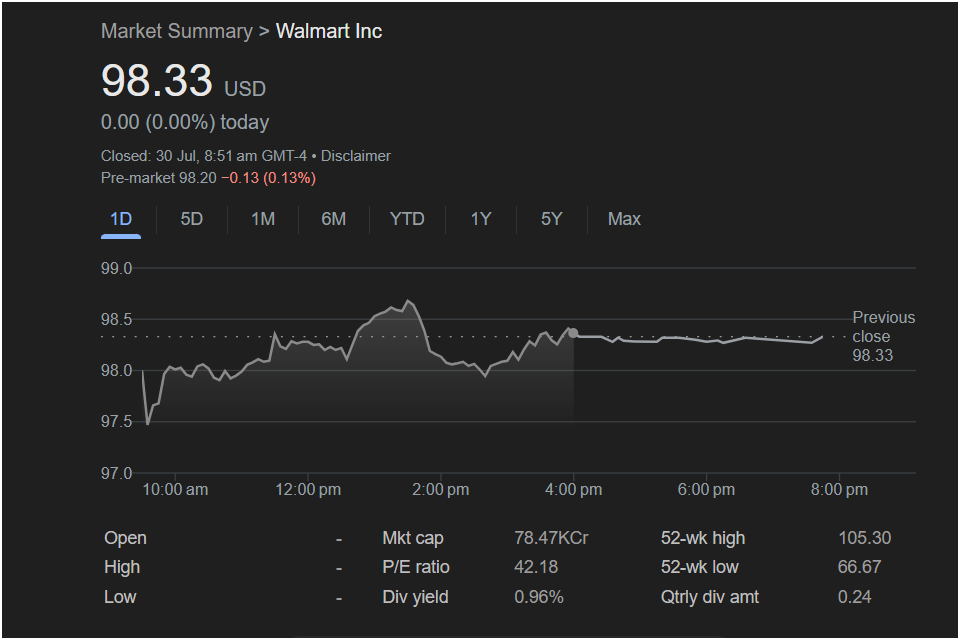Walmart (WMT) Stock Finishes Flat in Volatile Session: A Deep Dive Into The Numbers

NEW YORK – In a trading session that was anything but flat, shares of retail behemoth Walmart Inc. (NYSE: WMT) concluded the day in a statistical dead heat, closing at $98.33, precisely unchanged with a 0.00% move. This rare, static finish, however, belies a day of significant intraday volatility and raises critical questions for investors as key valuation and income metrics paint a complex picture of the company’s market standing.
As the closing bell rang, the numbers settled, but market sentiment remained in motion. Pre-market data indicated a slight dip on the horizon, with shares quoted at $98.20, down 0.13%, signaling a potential bearish start to the next trading day. For investors and market analysts, the uneventful close only serves to highlight the underlying tug-of-war between bullish conviction and bearish caution surrounding one of America’s most iconic companies.
A Day of Peaks and Valleys
The one-day chart for Walmart stock tells a story of a battle fought between the $97 and $99 price levels. The session opened with immediate selling pressure, pushing the stock down to what appears to be its intraday low, testing support near the $97.50 mark shortly after 10:00 am. This initial dip suggested that bears had the early advantage, potentially looking to capitalize on broader market jitters or company-specific concerns.
However, the morning weakness gave way to a powerful midday rally. Buyers stepped in with force, driving a steady ascent that culminated in a session high of approximately $98.70 in the early afternoon. This surge demonstrated resilient demand for the stock, as investors bought the dip and pushed the price back toward the upper end of its recent trading range. The rally stalled before it could challenge the psychologically important $99 level, and the gains began to erode in the final hours of trading. The stock then entered a consolidation phase, drifting sideways before settling exactly at its previous closing price of $98.33—a testament to the perfect equilibrium reached between buyers and sellers by day’s end.
Context is Key: The 52-Week Perspective
Today’s price of
66.67** to a high of $105.30. This context is crucial. It shows that Walmart has delivered substantial returns for shareholders over the past year, with the current price reflecting a period of strength and consolidation near its peak valuation.
Being less than 7% away from its 52-week high suggests strong investor confidence and positive business momentum. However, it also places the stock at a potential crossroads. For bulls, this is a launching pad for an assault on new highs, driven by the company’s strategic initiatives. For skeptics, it represents a potentially over-extended valuation that could be ripe for a pullback, especially if macroeconomic headwinds intensify.
The Valuation Question: A Sky-High P/E Ratio
Perhaps the most striking figure on Walmart’s financial dashboard is its Price-to-Earnings (P/E) ratio of 42.18. This metric, which measures the company’s stock price relative to its annual earnings per share, is significantly elevated for a mature, blue-chip retailer. For comparison, the historical average P/E for the broader S&P 500 index hovers around 20-25, placing Walmart in the territory typically reserved for high-growth technology companies, not established consumer staples.
A P/E ratio this high signals that the market is pricing in exceptionally strong future earnings growth. Investors are willing to pay a premium of over $42 for every one dollar of Walmart’s current earnings. This optimism is likely fueled by the company’s aggressive expansion into e-commerce, the growth of its Walmart+ subscription service, its burgeoning advertising business, and its ventures into healthcare and financial services. These initiatives represent a fundamental transformation from a brick-and-mortar giant into a diversified, omnichannel ecosystem.
The risk, however, is equally significant. If this anticipated growth fails to materialize or falls short of lofty expectations, the stock’s premium valuation could be difficult to sustain, making it vulnerable to a sharp correction.
The Income Story: A Modest Dividend Yield
Contrasting with its high-growth valuation is Walmart’s relatively low dividend yield of 0.96%. Based on a quarterly dividend payment of $0.24 per share, the annual payout offers investors a return of less than one percent at the current stock price.
This modest yield reflects a strategic choice. While Walmart has a long history of returning capital to shareholders, the current low yield suggests that the market’s focus—and perhaps the company’s capital allocation strategy—is geared more towards reinvesting for growth than providing substantial income. As the stock price has appreciated, the dividend yield has naturally compressed. This dynamic positions WMT less as a traditional income stock and more as a “growth at a reasonable price” (GARP) or even a pure-play growth investment, a paradigm shift for the decades-old retailer.
Unpacking the Data: Market Cap and Financial Health
While the provided image lists a market capitalization of “78.47KCr,” this appears to be a data-labeling anomaly, likely using an Indian numbering convention (“Thousand Crores”) that drastically understates the company’s true scale. The actual market capitalization of Walmart Inc. at this price point stands in the hundreds of billions of dollars, solidifying its position as one of the largest and most valuable corporations in the world.
This immense scale provides Walmart with a formidable competitive moat, including unparalleled supply chain logistics, massive purchasing power, and a physical footprint that reaches nearly every American community. It is this foundation of stability, combined with its forward-looking growth ventures, that creates the complex investment thesis currently facing the market.
As investors digest the day’s flat close, they are left to weigh these conflicting signals. Is Walmart a stable, defensive stalwart weathering economic uncertainty, or is it a high-growth innovator whose premium valuation is justified by its future potential? The stock’s performance in the coming sessions, as it navigates pre-market pressures and the ongoing battle around the $98 level, will offer the next clue.





